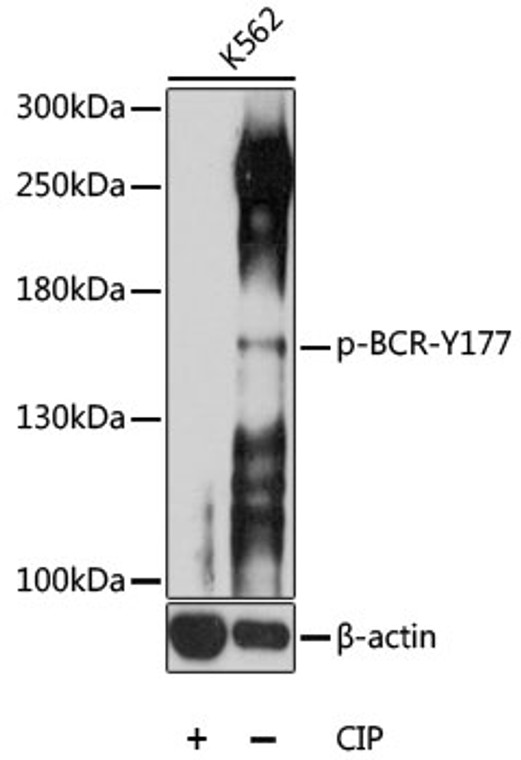| Host: |
Rabbit |
| Applications: |
WB |
| Reactivity: |
Human/Mouse |
| Note: |
STRICTLY FOR FURTHER SCIENTIFIC RESEARCH USE ONLY (RUO). MUST NOT TO BE USED IN DIAGNOSTIC OR THERAPEUTIC APPLICATIONS. |
| Short Description: |
Rabbit polyclonal antibody anti-Phospho-BCR-Y177 is suitable for use in Western Blot research applications. |
| Clonality: |
Polyclonal |
| Conjugation: |
Unconjugated |
| Isotype: |
IgG |
| Formulation: |
PBS with 0.02% Sodium Azide, 50% Glycerol, pH7.3. |
| Purification: |
Affinity purification |
| Dilution Range: |
WB 1:500-1:2000 |
| Storage Instruction: |
Store at-20°C for up to 1 year from the date of receipt, and avoid repeat freeze-thaw cycles. |
| Gene Symbol: |
BCR |
| Gene ID: |
613 |
| Uniprot ID: |
BCR_HUMAN |
| Immunogen: |
A synthetic phosphorylated peptide around Y177 of human BCR (NP_004318.3). |
| Immunogen Sequence: |
PFYVN |
| Post Translational Modifications | Autophosphorylated. Phosphorylated by FES/FPS on tyrosine residues, leading to down-regulation of the BCR kinase activity. Phosphorylation at Tyr-177 by HCK is important for interaction with GRB2. |
| Function | Protein with a unique structure having two opposing regulatory activities toward small GTP-binding proteins. The C-terminus is a GTPase-activating protein (GAP) domain which stimulates GTP hydrolysis by RAC1, RAC2 and CDC42. Accelerates the intrinsic rate of GTP hydrolysis of RAC1 or CDC42, leading to down-regulation of the active GTP-bound form. The central Dbl homology (DH) domain functions as guanine nucleotide exchange factor (GEF) that modulates the GTPases CDC42, RHOA and RAC1. Promotes the conversion of CDC42, RHOA and RAC1 from the GDP-bound to the GTP-bound form. The amino terminus contains an intrinsic kinase activity. Functions as an important negative regulator of neuronal RAC1 activity. Regulates macrophage functions such as CSF1-directed motility and phagocytosis through the modulation of RAC1 activity. Plays a major role as a RHOA GEF in keratinocytes being involved in focal adhesion formation and keratinocyte differentiation. |
| Protein Name | Breakpoint Cluster Region ProteinRenal Carcinoma Antigen Ny-Ren-26 |
| Database Links | Reactome: R-HSA-1839117Reactome: R-HSA-5655302Reactome: R-HSA-8980692Reactome: R-HSA-9013026Reactome: R-HSA-9013106Reactome: R-HSA-9013148Reactome: R-HSA-9013149Reactome: R-HSA-9013404Reactome: R-HSA-9013423 |
| Cellular Localisation | Postsynaptic DensityCell ProjectionDendritic SpineAxonSynapse |
| Alternative Antibody Names | Anti-Breakpoint Cluster Region Protein antibodyAnti-Renal Carcinoma Antigen Ny-Ren-26 antibodyAnti-BCR antibodyAnti-BCR1 antibodyAnti-D22S11 antibody |
Information sourced from Uniprot.org
12 months for antibodies. 6 months for ELISA Kits. Please see website T&Cs for further guidance








